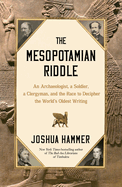
With The Mesopotamian Riddle, Joshua Hammer (The Bad-Ass Librarians of Timbuktu) has written an engaging and fast-paced history of the rediscovery of Mesopotamian cuneiform during the Victorian era. On paper, upper-class Henry Rawlinson, a British diplomat in Baghdad, had little in common with Austen Layard, a law clerk turned archeologist, and Edward Hincks, a curmudgeonly Irish clergyman. But what Rawlinson, Layard, and Hincks did share was a fascination with the Middle East.
By the mid-19th century, when the discovery of Assyrian palaces led to thousands of inscribed tablets from the Assyrian royal library, the civilization of ancient Mesopotamia had been "almost entirely forgotten." Scholars in the 1840s still were not sure whether cuneiform was a Semitic language, or exactly which culture it belonged to. The "rediscovery of this lost civilization... seized the public's imagination" and led to the Royal Asiatic Society arranging a competition to see who could most accurately translate a relic "inscribed with eight hundred lines of tiny cuneiform characters." Layard and Rawlinson both traveled in what is now Iraq and Iran, uncovering treasures on archeological digs, while Hincks, who had limited resources, translated from Ireland via the casts and impressions of artifacts created by others.
Reading about their adventurous efforts, their "feat of analysis, intuition, and stamina," and seeing cuneiform interspersed in the book's text is truly fascinating. Finally, the Mesopotamian Riddle had been solved, and once again the symbols could be read. The story of the rivalries among these three men, interspersed with the history they uncovered as they translated, makes for irresistible reading. History buffs, adventure seekers, and linguists will all love The Mesopotamian Riddle. --Jessica Howard, former bookseller, freelance book reviewer

